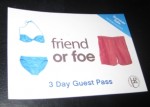I recently I got not one but two emails from people I never heard of.
They were offering me the opportunity to buy targeted opt-in email marketing lists. They bragged about their high profile, Fortune 500 clients.
Is this a joke?
Do I want to buy their lists? No, NO, and NO!
You shouldn’t either.
Why you shouldn’t buy email lists
It’s tempting to go out and buy a list from InfoUSA or other vendors that promise thousands or millions (!) of addresses at low rates — (and you own the list).
Sounds good, right? It’s a mistake. The list is probably scraped from website contact information, pulled from directories, or gathered on the sly from pre-checked boxes sneakily added to signup forms.
The permission to contact is questionable, and the data is probably old. You’re likely to be spending time (and money) sending messages that will never reach anyone.
Email costs less than snail mail, but high bounce rates and poor deliverability will not endear you to your email service provider. And, there are costs in time and effort to develop, write, format, and send the email (since many email providers charge by the size of your list).
What about renting a list?
This can work under certain conditions. However, high quality rented email lists (particularly business to business lists) tend to be very expensive.
They start at about $100 per thousand names and go up to $300 per thousand names. Be careful about which lists you use and how often you use them.
Build a qualified opt-in email list for free
The best way to build an email list is to grow it organically, starting from scratch.
1. Add a signup offer to your blog. Put them in several different places so readers will see them when they start reading, and while they browse. Don’t just add the offer, include a report, an analysis, or some other valuable information in return for signing up.
For instance, if you’re a web site designer, offer a booklet called, “10 Things Your Web Designer Doesn’t Want You to Know.” Or, “Has Your Web Designer Made These Common Web Design Mistakes?” A video editor might offer, “5 Strategies to Minimize Your Video Production Costs.”
Or, create an automated e-mail course. Once you set it up, the messages will be sent out automatically to anyone who signs up.
If you’re stuck for a topic, think about some common questions your customers ask you, or problems you frequently solve and write a guide on how to fix them.
2. Join relevant forums and groups. Be helpful, not annoying. Mention the ebook or guide, when it’s useful and appropriate. Add the link to your signature, profile page, or about page on those sites.
Don’t yell at people, connect with them. They’re people, not targets. Stop shouting and start listening, then ask them for permission to listen to you.
3. Use social media. If you’re on Twitter or Facebook or other social networking sites, tell your friends and followers about your new newsletter. Don’t spam them with continuous tweets, but share tidbits, relevant quotes, or other information that will raise their interest. Then give them the opportunity to subscribe.
4. Start with the people you already know. Send an email to current clients or prospects and tell them about your new newsletter. Talk about all the great information they’ll get, the kinds of topics you are going to cover, and include a link to sign up.
Offer them the opportunity to get in first, before anyone else.
5. Hold webinars or Google Hangouts on Air. This can be a continuing series that you host, or regular guest appearances on others’ events. Give viewers the opportunity to sign up (add a link to the presentation, or ask your host to include one). Make the link simple and easy to remember!
6. Borrow an existing audience. First, find a newsletter or blog your potential and current clients already read. If they accept guest posts, offer to write one. If they have a newsletter, see if you can sponsor it or advertise.
Even better, if you have a partner or vendor with a similar audience, ask if you can write an article for their newsletter with a special offer for their readers (make it an exclusive).
Once you have built your own email list, see if you can swap offers: you include their offer in your newsletter and vice versa.
7. Run pay-per-click ads, a Facebook campaign, or ads on LinkedIn. Ads aren’t free, but they are much cheaper than buying thousands of email names. Use AdWords to find people while they’re actively searching for something. Or, get them on LInkedIn or Facebook when they’re networking or relaxing. If your book or guide answers a question your audience is struggling with, they’ll want to read it. Make sure to send them to a targeted landing page, not your home page.
The important thing is to approach building your email list from the perspective of being helpful, not pushy. Give your readers, viewers, and followers solutions to their problems (not yours).
Focus on building trust first, sales later.
 New York City’s streets are full of fruit stands. Bananas for 25 cents each or a pound of grapes for $1.50. The prices are much lower than the markets and the fruit is fresh.
New York City’s streets are full of fruit stands. Bananas for 25 cents each or a pound of grapes for $1.50. The prices are much lower than the markets and the fruit is fresh.



